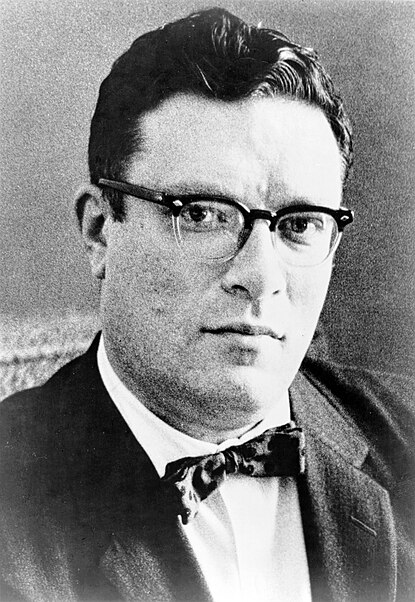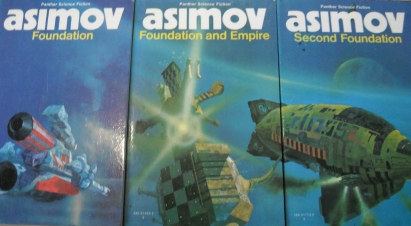 Of all the science fiction I read as a kid, the dominant force was Isaac Asimov. It seems only right that I should begin my series of pieces on the influences behind Johnny Mackintosh with this master of “hard” sci fi.
Of all the science fiction I read as a kid, the dominant force was Isaac Asimov. It seems only right that I should begin my series of pieces on the influences behind Johnny Mackintosh with this master of “hard” sci fi.
My local library contained copies of a series of books about a young Earth hero called Lucky Starr who was always saving Earth from the upstart human colonists of Sirius – as part of their plans for galactic expansion these Sirians wanted to return to take over their homeworld. Nowadays I don’t remember much of the stories, apart from some legalistic dispute over control of the Jovian system (or was it Saturn?) and I’m pretty sure that, even here, the books contained Asimov’s famous Laws of Robotics.
Where the great man came into his own and his ideas stayed with me was the Foundaion Trilogy. I say “trilogy” – there are officially seven books but two prequels and two sequels were written later and in my opinion should be avoided. Far better to stick to the original three: Foundation, Foundation and Empire and Second Foundation.

There’s a key idea in the books that concerns a mathematical theory of human behaviour. “Psychohistory” of which the greatest protagonist is Hari Seldon, is like a kinetic theory of gases for human beings – gather enough of us together (and the starting premise of the books is that humanity has colonized the entire galaxy so there are lots of people) and the overall, en bloc behaviour becomes statistically predictable. It’s an idea that always appealed to my own mathematical sensibilities – in my teenage years I thought long and hard about how it might work in practice. Asimov is aware of its potential flaws and cleverly builds them into the plot.
The book begins in the final centuries of galactic empire (although this demise isn’t obvious to the vast majority of the galaxy’s inhabitants). What Seldon did was to apply the equations of Psychohistory to predict the fall of Empire and a thirty-thousand-year period of anarchy – an equivalent of our Dark Ages – before a galactic civilization could reassert itself. It was too late to prevent the fall but by creating the Foundation on the rim of the galaxy he could cut those in-between times to just a single millennium.
*********SPOILER ALERT – do not read unless you have finished both Johnny Mackintosh and the Spirit of London and Johnny Mackintosh: Star Blaze**********
The original settlers of the Foundation, believers in Seldon’s vision, were mainly scientists. Resources were deliberately kept scarce, forcing them to improvise and innovate. They created a device that features in my own stories – a personal shield. Something to wear around your neck that will protect you from blaster fire. In Asimov’s books these become the stuff of legend, and I wanted the same for mine.
***********END OF SPOILERS************
A second element I borrowed from the Foundation trilogy was the galactic capital. My Melania is similar to Asimov’s Trantor, in that every square inch of the planet has been built upon. In fact, Melania has an artificial second skin. On both worlds the only piece of greenery where natu

Dear Mr. Gates:
You have, by dint of your intelligence and sincerity, become a major spokesman for wealthy Americans calling for higher taxes. Since the nation’s budgetary problems will only be solved by combining spending reductions with tax increases, this is a compelling claim.
However, the devil, as they say, is in the details. Allow me to call three details to your attention:
1) Microsoft’s tax avoidance. Microsoft has become increasingly adept at parking its profits in low tax foreign jurisdictions, rather than paying U.S. taxes. After analyzing Microsoft’s financial statements, Tax Analysts’ Martin A. Sullivan recently concluded that Microsoft “has dramatically stepped up its efforts to take advantage of lax U.S. transfer pricing rules.” In lay terms, Microsoft is avoiding U.S. taxes by accounting maneuvers which shift its profits to low tax havens.
Of course, Microsoft is not alone in this behavior. However, Microsoft is the source of your family’s wealth and influence. I suggest that you start a campaign to press U.S. corporations to pay U.S. taxes and that you lead with Microsoft as the campaign’s first target.
2) Millionaires and billionaires are different. You are the leading proponent of the plan to establish an income tax in Washington State. The tax will be levied at a rate of 5% on annual incomes over $200,000 ($400,000 for couples). The rate will increase to 9% on annual incomes over $500,000 ($1,000,000 for couples).
Individuals earning these kinds of incomes are undoubtedly affluent. But few of them are software billionaires. Unfortunately, the Washington State levy will tax millionaires and billionaires at the same rates.
Many individuals triggering the first tier of the Washington income tax will be professionals like me. Many of the individuals triggering the higher tax level will be small businessmen and businesswomen. As to this latter group, the Washington tax will be among the nation’s highest. For these people, the tax will impose a noticeable burden and could lead to economic distortions such as a decision to leave Washington for a state with a low or no income tax.
It is neither fair nor efficient for the billionaires of Microsoft to pay the same marginal tax rates as these other taxpayers.
I suggest that you call for a third, substantially higher rate for the Washington State tax to apply to individuals such as you. The resulting revenues would permit a reduction of the rates applying to other, less affluent Washington State taxpayers.
3) The Gates Foundation is a tax shelter. The Gates Foundation does great work of which you and your family can be justifiably proud. But there is one thing the Gates Foundation doesn’t do: pay taxes.
You and your son have both been outspoken proponents of federal estate taxation. However, the resources you and he contribute to the Gates Foundation avoid such taxation. Moreover, the foundation, as a tax-exempt entity, pays no federal income tax.
I understand and applaud the charitable impulse which animates the Gates Foundation. My wife and I have established a private foundation in memory of our son though this fund is, needless to say, much smaller than the Gates Foundation.
It is, nevertheless, problematic to call for others to pay higher estate and income taxes while the Gates Foundation, one of the country’s largest, effectively shelters your and your son’s incomes and estates from the federal fisc.
I urge that the Gates Foundation annually and voluntarily
I planned to post about YALSA’s Board meetings every day of Midwinter. But, as they say, “The best laid plans….”
Following the Saturday 1/16/10 meeting, the YALSA Board met twice more and the hard-working members continued to strategically plan for the Association. Items on the agenda on Sunday and Monday were discussion items. That means that what was discussed was not slated for specific action. Items listed as discussion usually are related to topics that haven’t yet been discussed by the Board and which may need more thought, and perhaps revision, before placed on a future agenda for a specific action. Discussion items can be acted on, but they do not have to be. An overview of topics discussed on Sunday, 1/17/10, and Monday, 1/18/10, follows.
- At both Annual Conference and Midwinter Meeting, the YALSA Board receives an update on the Association’s financial health. This update is provided by YALSA’s Fiscal Officer, Mary Hastler, and Executive Director, Beth Yoke. The report at Midwinter included suggestions that help guarantee that during financially difficult times, YALSA remains financially secure. The YALSA Board will continue to consider ways to control expenses and maximize revenues while meeting member needs. The full financial report is available on the YALSA web site.
- Over the past couple of years the YALSA Board has spent some time discussing the possibility of the Association starting a foundation. The reasons for this are multiple and include that a YALSA foundation could help the Association to better manage fundraising efforts. The YALSA Board decided to go forward with an investigation of this concept and has asked me to contact YALSA’s representative to the Executive Board to discuss whether or not it is feasible, within the ALA structure, to continue to explore YALSA foundation possibilities. The document related to foundations which the Board discussed is available on the YALSA web site.
- In the fall YALSA member Sarah Flowers worked with a task force to revise YALSA’s competences for librarians serving teens. Sarah presented the revised document to the YALSA Board and discussed with Board members the changes and decisions made during the revision process. Changes include a simplifying of language and embedding of technology into the entire set of competencies. The Board approved the revised competencies and the update will be released and distributed soon. The revised document is available on the YALSA web site.
- In 2004 a task force charged with coming up with recommendations for use of the William C. Morris Endowment interest funds included in their report that after five years the use of the funds should be evaluated. A draft evaluation report (prepared by an ad hoc committee of the Board, Chaired by Mary Hastler) was presented to the Board. The report included an overview of the ways in which the funds have been spent to date and ideas for future use of the monies. Ideas covered in the document include possible grants and awards for librarians and authors. After some initial discussion, it was determined that the Board needs to spend more time looking at the possibilities and to think strategically about the best ways to s
 Of all the science fiction I read as a kid, the dominant force was Isaac Asimov. It seems only right that I should begin my series of pieces on the influences behind Johnny Mackintosh with this master of “hard” sci fi.
Of all the science fiction I read as a kid, the dominant force was Isaac Asimov. It seems only right that I should begin my series of pieces on the influences behind Johnny Mackintosh with this master of “hard” sci fi.




